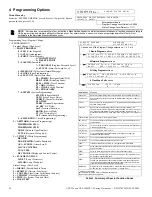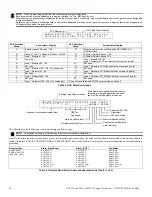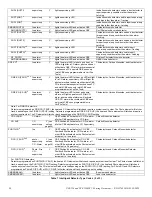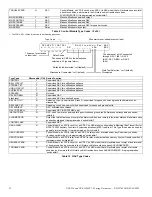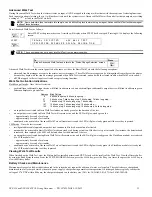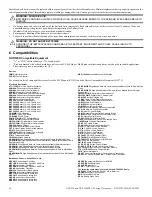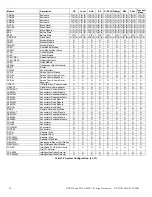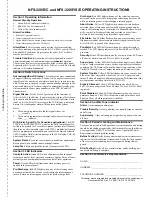
NFS-320 and NFS-320SYS UL Listing Document —
P/N 52745LD:G9 5/19/2022
33
5 Testing/Maintenance
When finished with the original installation and all modifications, conduct a complete operational test on the entire installation to verify compliance
with applicable NFPA standards. Testing should be conducted by a factory-trained fire alarm technician in the presence of a representative of the
Authority Having Jurisdiction and the owner’s representative. All test and maintenance instruction codes and software necessary to provide test and
inspection requirements of CAN/ULC-S536, Standard for the Inspection and Testing of Fire Alarm Systems. Follow procedures outlined in NFPA
Standard 72’s section on
Inspection, Testing and Maintenance
.
Disable or Enable a Point
The Disable/Enable option lets you disable programmed points for detectors, modules,
zones, and NACs. The program allows you to disable an initiating device in alarm: however,
the disable will not take effect until after the panel has been reset.
1.From the “Status Change Selection” screen, press the
1
key to display the “Disable/Enable”
screen.
2.Select the point type.
The cursor will blink the first SLC address digit in the detector, zone, module, or NAC field.
3.
Enter the address of the point, then press the
ENTER
key. A sample display follows:
Periodic Testing and Service
Periodic testing and servicing of the control panel, all initiating and notification devices, and any other associated equipment is essential to ensure
proper and reliable operation. Test and service the control panel according to the schedules and procedures outlined in the following documents:
•
NFPA Standard 72’s section on
Inspection, Testing and Maintenance
.
•
Service manuals and instructions for the peripheral devices installed in the system. Correct any trouble condition or malfunction immediately.
•
Drill (Alarm Signal On for Canadian applications) Use the Drill/Alarm Signal On key to manually activate all silenceable outputs and NACs.
Press and hold the Drill/Alarm Signal On key for 2 seconds. During a drill, the panel will turn on all silenceable NACs, Turn off the Signals
Silenced LED, and sends a Manual Evacuate message to the History Buffer and installed printers, CRT-2 terminals and annunciators.
•
Lamp Test - Use the Lamp Test key to test the control panel LEDs and panel sounder. Press and hold the key. The panel will light all control panel
LEDs, turn on the panel sounder, and light all segments of the LCD display. If the Lamp Test key is held longer than 5 seconds, the LCD will
display the software revisions.
Operational Checks
•
Before proceeding: a) notify the fire department and the central alarm receiving station if transmitting alarm conditions; b) notify facility
personnel of the test so that alarm sounding devices are disregarded during the test period; and c) when necessary, disable activation of alarm
notification appliances and speakers to prevent their sounding.
•
Disconnect all releasing devices to prevent accidental activation in accordance with NFPA 2001 and NFPA 12A releasing agents.
•
Check that the green POWER LED lights.
•
Check that all status LEDs are off.
•
Press and hold the LAMP TEST key. Verify that all LEDs and all LCD display segments work.
•
Activate an Initiating Device Circuit using an alarm initiating device or an addressable initiating device on the SLC and check that all
programmed active notification appliances function. Reset the alarm initiating device, the control panel, and any other associated equipment. In
voice alarm applications, confirm that the proper tone(s) and/or messages sound during alarm conditions. Select the paging function and confirm
that the message can be heard in the affected fire zones. Repeat the above step with each Initiating Device Circuit and each addressable device.
•
On systems equipped with a fire fighter’s telephone circuit, make a call from a telephone circuit and confirm a ring tone. Answer the call and
confirm communication with the incoming caller. End the call and repeat for each telephone circuit in the system.
NOTE:
Use 0 (zero) ohm impedance when testing wire-to-wire faults.
!
WARNING: DO NOT USE SOFTWARE FOR RELEASING LOCKOUT
DO NOT RELY ON DISABLE/ENABLE SOFTWARE SETTINGS TO LOCK OUT RELEASING DEVICES. RELEASING
DEVICES MUST BE PHYSICALLY DISCONNECTED.
NOTE:
When an input or output point associated with releasing functions is disabled, a single supervisory trouble will be
generated.
!
WARNING: ZONE DISABLE
DISABLING A ZONE DISABLES ALL INPUT AND OUTPUT DEVICES THAT USE THE ZONE AS THE FIRST ENTRY IN THE
CBE LIST.
!
WARNING: RELEASING DEVICES MUST BE PHYSICALLY DISCONNECTED
DO NOT RELY ON DISABLE/ENABLE SOFTWARE SETTINGS TO LOCKOUT RELEASING DEVICES.
Status Change
Password
for detectors
for modules
for NACs
for zones
E N A B L E C O N T R O L
C O N T R O L A D D R E S S 1 M 1 0 1
0 0 _ _ _ _ _ _ _ _ I S W 1 M 1 0 1
Blinking status banner (ENABLE or DISABL)






